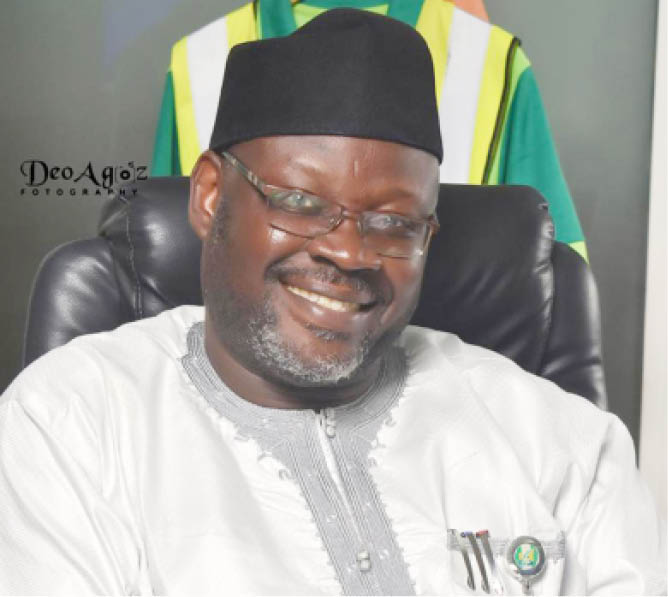Outdoor advert revenue goes into personal pockets – DOAS
Dr. Babagana Adam is the Director of the Department of Outdoor Advertisement and Signage (DOAS) of the Federal Capital Territory Administration (FCTA). In this interview, he says most of the revenue that should be realised by the department go into personal pockets. What are the functions of DOAS? Strategically they are three: to control, regulate […]

Dr Babagana Adam, Director, Department of Outdoor Advertisement and Signages (DOAS) FCTA
Dr. Babagana Adam is the Director of the Department of Outdoor Advertisement and Signage (DOAS) of the Federal Capital Territory Administration (FCTA). In this interview, he says most of the revenue that should be realised by the department go into personal pockets.
What are the functions of DOAS?
Strategically they are three: to control, regulate and standardise outdoor advertisement – the billboards you see on the streets, the signage you see on hotels, restaurants, filling stations, etc. We control it, standardise it and regulate it so that it is safe for humans and property.
Number two is to maintain the aesthetics of the city, and number three is to ensure that the environment is protected and that billboards don’t come in substandard forms – like the proliferation of illegal and substandard structures – and finally through this process we are supposed to also generate revenue so that our organisation can function properly without debilitating government resources that are meant for social welfare.
What are the categories of the billboards that are to be erected?
We have three: we have the first party – that is any signboard or signage within five metres of your property or where you are renting is called first party. In this category you deal directly with DOAS. It can be a hotel, a mall, shop, filling station or any business.
Second party is mainly governmental: security agencies and NGO signage. Then we have the third party; here you’re engaging a professional media practitioner who knows about marketing and advertisement. He now places them on billboards across streets. This is outside five metres of business premises. The media consultant comes to DOAS as the regulator, and mostly they have big billboards of whatever size that is acceptable to the environment.
Within some of these, like under the first party, we have mobile advertisement – anything that is mobile – that is carrying around any brand that is being promoted.
Then there’s outreach; companies can advertise products by organising dancers and conducting some sort of one-off shop. It is like the mobile advertisement.
What are the rates for each category?
The rates depend on the size and the size depends on where you are putting it. So we have rural, urban and restricted areas. If you are in a satellite town like Bwari or Kuje, the lowest in the first party in the rural areas is N12,700. Then the outreaches per day, the lowest is N30,000 per day; depending on the quantity, the number of streets you want to follow. But we want to ensure safety, then convenience, then the beauty of the environment, and then the revenue aspect comes in.
Then for billboards, the smallest is about N12,000 per month; that is the lamp post which is about 1.8 metres. The ones you see on street lights, that is for third party franchise, are N12,000 per pole. Along Airport Road, its higher because it is in a prime location and its N24,000. But we have ones that are up to N2.5m per phase per annum. We try to ensure the best use of space. And we try to ensure there is a balance between the regulator and the clientele.
Which one generates the highest revenue?
For the three categories, it is supposed to be 60 per cent for the first party. We just conducted a enumeration exercise for AMAC and the other area councils. We have about 9,000 billable units in AMAC alone, the other five area councils put together have about 6,000 billable units, roughly 15,000 in all. We want to have a scientific approach to revenue generation in the FCT. By this we have their addresses and numbers; which make the marketing easy.
How much has been generated so far by DOAS?
So far, despite the lockdown we have been able to generate between January and now, about N500m, but our expectation is higher than that; we could have got up to a billion. Last year we generated about N500m also.
What challenges do you face in carrying out your mandate?
They are enormous; some of the key ones are that people are not respecting some of the agreements we signed, like the area councils. DOAS is supposed to collect signage, we don’t know why a task force claiming to be working for AMAC would write a letter claiming money.
Secondly, people go shopping for judgement in different courts. Some courts have granted judgement that DOAS is illegal and should be scrapped. In a case you’re not even invited to make a defense. But we have a by-law establishing the department in 2013. DOAS came into effect in 2012.
When we collect revenue we share the money with the area councils, but when they collect they keep to themselves. So people are shopping for judgements, and along the line, the FCTA is losing a lot of money because it goes to private pockets.
Also, we need more logistics to carry out our activities. From every N1 they give us we can generate N10,000 at DOAS.
We are calling on the general public to cooperate with us, never pay cash to anybody, pay to DOAS designated TSA or the Remita account.
